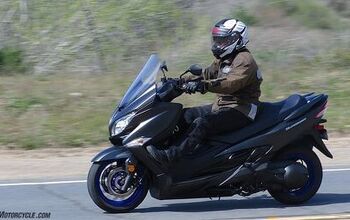What's the Speed Limit for Lane Splitting?

Keeping it legal in the Golden State
Lane-splitting, as the practice of riding a motorcycle between lanes of stopped or slow-moving vehicles is called, is technically legal in just one U.S. state. That means there is no speed limit for lane-splitting, as you can’t do it legally at any speed! But in California, where it is legal, are there actual rules about how you do it?
The short answer is to keep your speed differential below 10 mph and keep your overall speed under 30 mph. But those aren’t the law – instead, they’re recommendations based on studies of lane-splitting behaviors.
Here’s the long answer – there is no speed limit just for lane-splitting. In California, lane-splitting is now formally a recognized and legal activity. Here’s the actual provision of the California Vehicle Code (CVC):
21658.1. (a) For the purposes of this section, “lane splitting” means driving a motorcycle, as defined in Section 400, that has two wheels in contact with the ground, between rows of stopped or moving vehicles in the same lane, including on both divided and undivided streets, roads, or highways.
Note there is no mention of how to do it, just that it’s “a thing.” The California legislature leaves safety up to the individual motorcyclist and also empowers the California Highway Patrol and other organizations to “develop educational guidelines relating to lane splitting in a manner that would ensure the safety of the motorcyclist and the drivers and passengers of the surrounding vehicles.”
Why does the law explicitly allow the CHP and others to give out lane-splitting advice? In the long, contentious road leading to the adoption of section 21658.1, the CHP posted guidelines about lane-splitting safety. Soon, a helpful citizen – concerned about governmental overreach – filed suit against the CHP to take them down, as there was no public review process before they were posted. As of this writing, there are no official guidelines from the CHP, but the 10-mph differential and 30-mph overall speed seems to be universally accepted.
So will you get a ticket if you exceed these 10/30 guidelines? Maybe! In California, and other states, there’s a “basic speed law” that states you can only ride as fast as conditions allow, leaving a lot of discretion to individual patrol officers. Talk to riders, and you’ll find that if you keep the speeds under 30 or 40 mph and don’t attract too much attention, you’ll likely never be pulled over for lane-splitting. Ride too fast, change lanes too much, or just behave like a jackass in general and you’ll risk attracting Johnny Law’s attention. Ride safe!

Motorcycle.com presents an unrivaled combination of bike reviews and news written by industry experts
More by Motorcycle.com Staff
































Comments
Join the conversation
"The short answer is to keep your speed differential below 10 mph and keep your overall speed under 30 mph. But those aren’t the law – instead, they’re recommendations based on studies of lane-splitting behaviors."
Oh, is that so? Which studies of lane-splitting behaviors are these recommendations based on?
Here is some text from the the Berkeley study http://lanesplittingislegal... :
"Lane-splitting appears to be a relatively safe motorcycle riding strategy if done in traffic moving at 50 MPH or less and if motorcyclists do not exceed the speed of other vehicles by more than 15 MPH." (top of page 4)
"Speed differentials of up to 15 MPH were not associated with changes in injury occurrence" (top of page 17)
Who wrote this feature? (The by line says, "Staff".)
You seem to misrepresent the findings of the most authoritative study ever done. Why?
Here in Ohio it's not specifically illegal but you can get cited for an illegal pass or failure to maintain lane. It should be legal everywhere